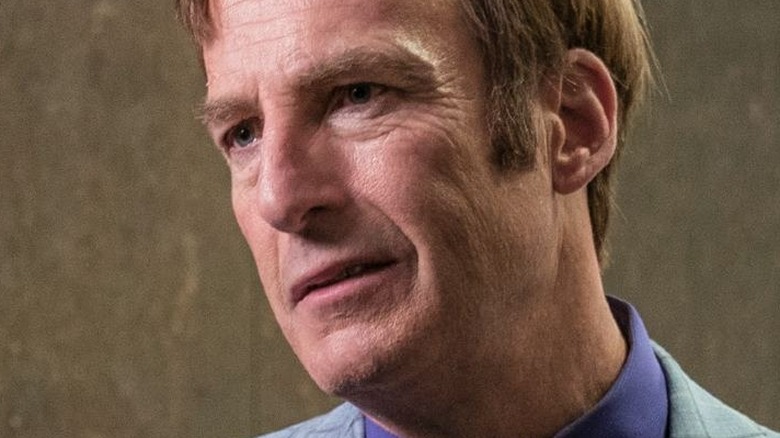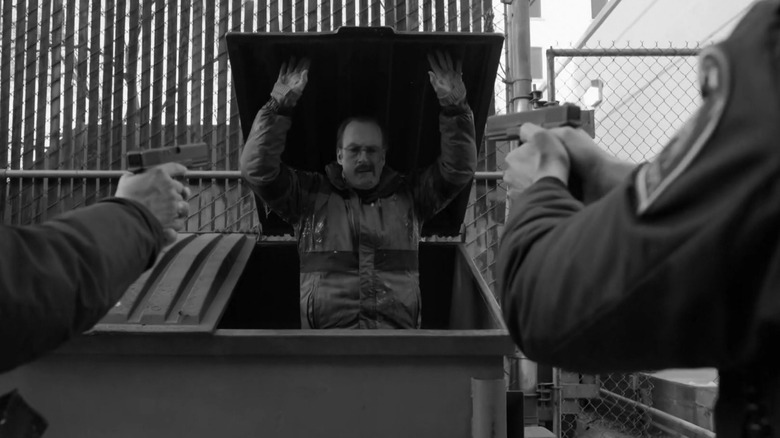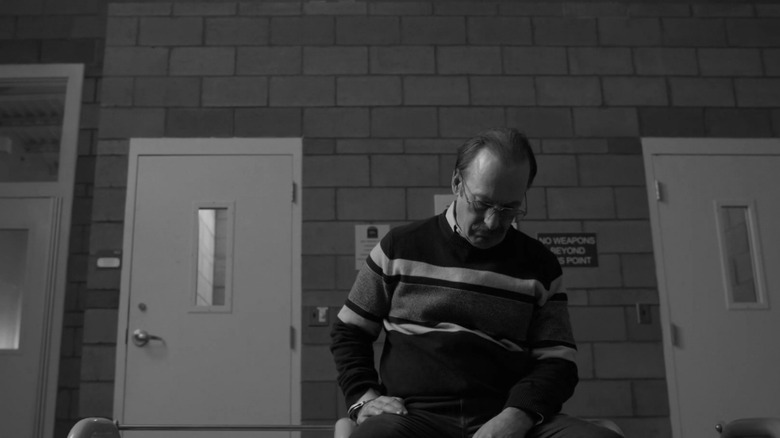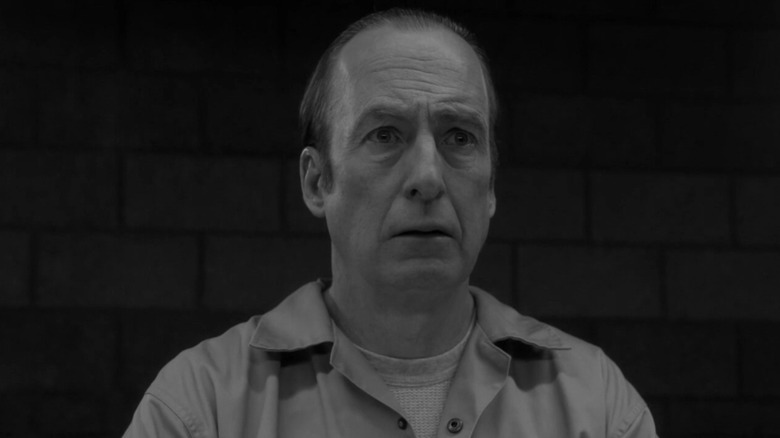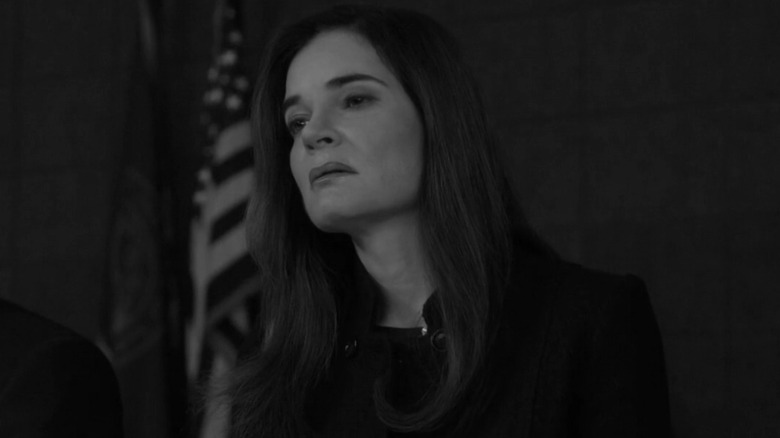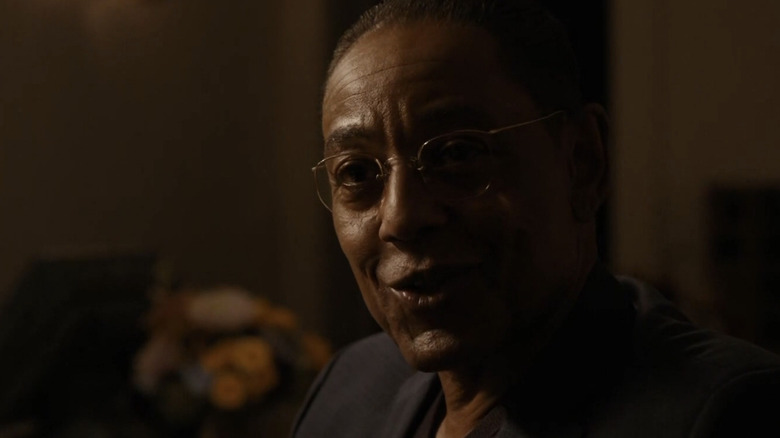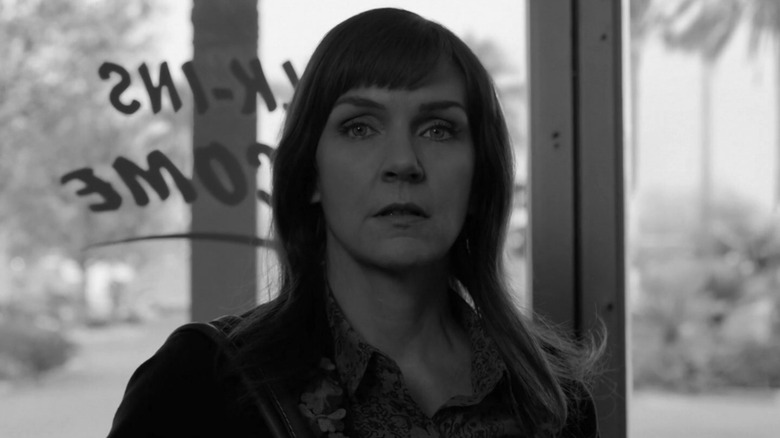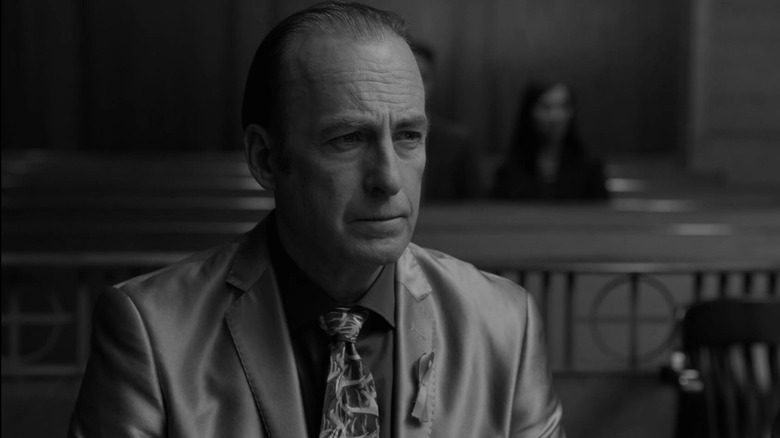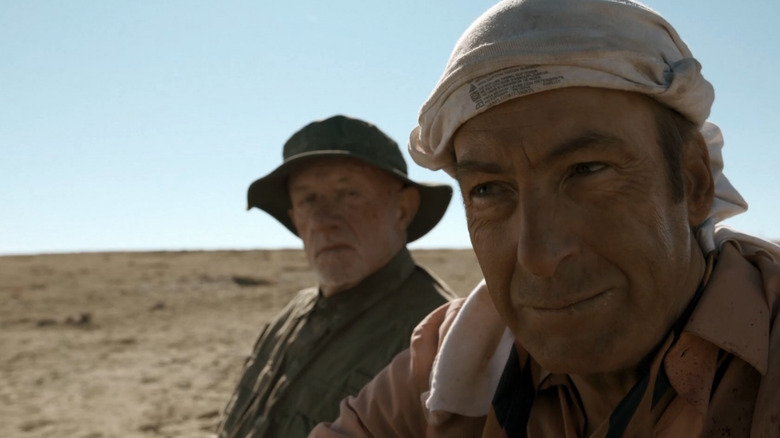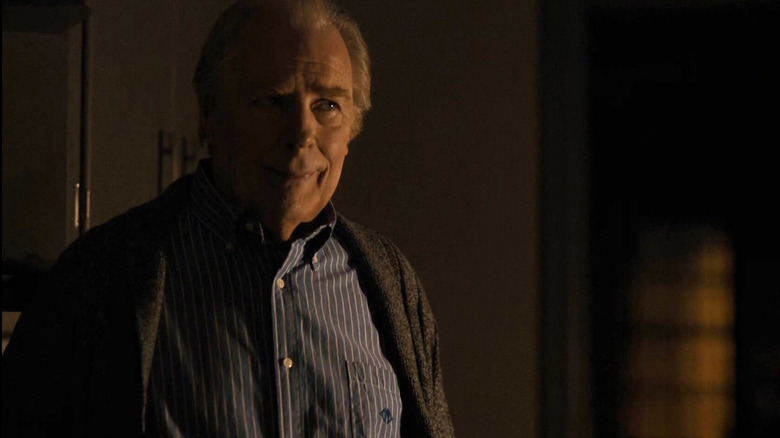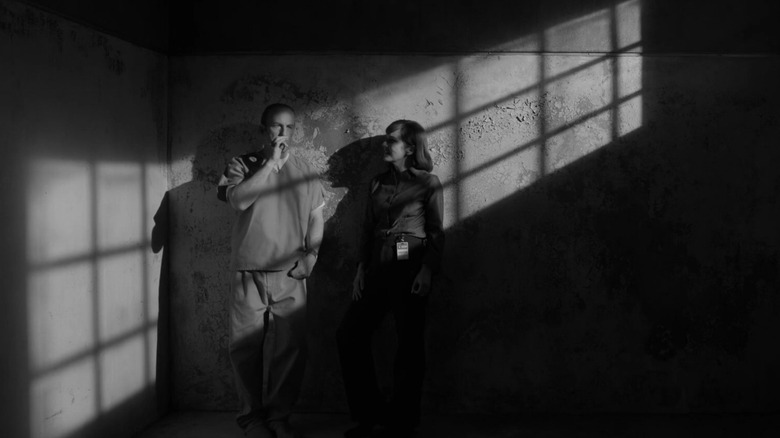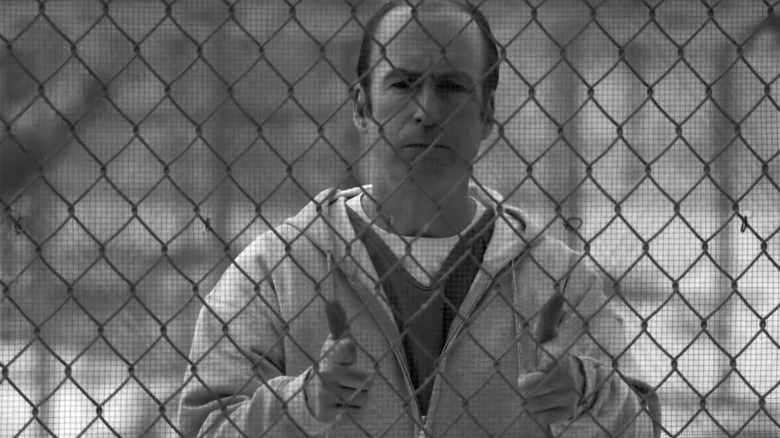The Ending Of Better Call Saul Explained
A prequel to "Breaking Bad," one of the great television dramas of the late 2000s and early 2010s, centering around that show's comic relief lawyer Saul Goodman, didn't always seem like a home run idea. Critics at Slate, for instance, thought it sounded terrible, at best a forgettable in the vein of creator Vince Gilligan's short-lived "The X-Files" spinoff "The Lone Gunmen," at worst a cheapening of the original show's legacy. However, Gilligan and co-creator Peter Gould pulled off the impossible with "Better Call Saul," building a subtle, hilarious, and emotionally devastating six seasons of television around the slow-motion corruption of Albuquerque attorney Jimmy McGill (Bob Odenkirk) — the rare prequel that stands as tall, if not taller, than its predecessor.
By the series' final episode, which aired in August 2022, McGill has lived under three names and identities. He starts as Jimmy, using his birth name, a hardworking lawyer who nonetheless can't resist a shortcut or scheme. He then becomes Saul Goodman, the professional name of an amoral ambulance chaser who aids and abets the murderous rise of drug kingpin Walter White. Finally, we see him as Gene Takovic, the manager of a shopping mall Cinnabon who lives in constant fear of his previous identities being discovered. These were all the same man, but at the same time very different from each other, and the final episode, "Saul Gone," gives each of them the ending they deserve. This is the ending of "Better Call Saul," explained.
The death of Gene Takovic
Gene Takovic died as he lived — hiding from the police in (both literal and metaphorical) garbage. After months of hiding in Omaha, buried under a thick mustache and thicker glasses, Gene dips his toe back into the grifter life after being recognized by dim-witted taxi driver Jeff (Don Harvey in Seasons 4 and 5, Pat Healy in Season 6). However, the erstwhile Slippin' Jimmy doesn't do anything halfway. His schemes become riskier, his true self comes through a little too much, and before long his cover is completely blown by Jeff's YouTube-savvy mother Marion (comedy legend Carol Burnett).
The final four episodes of the series primarily take place in the Gene Takovic era, which came as something of a surprise to creators Vince Gilligan and Peter Gould, who found themselves at the end of a show called "Better Call Saul" with relatively little Saul Goodman in it. "We were fascinated by Jimmy McGill," Gilligan said in an interview with Rolling Stone, "and then we wanted to see more of Gene Takovic in Omaha, so we kind of ran out the clock without even meaning to, and then we realized, man, the first thing that could go was Saul Goodman. And that's the name of the show!" In the end, it's only fitting that a man who was once so good at elder law would be finally brought to justice by an elderly person.
This is how they get you
Like his sort-of partner in crime Gus Fring, Gene is both a career criminal and a steadfast and reliable fast food employee. So when in the custody of the Omaha police, Gene uses his phone call to contact Cinnabon and let his staff know that he won't be coming in and that they need to contact the corporate office to provide a new manager. The Cinnabon storyline started as a throwaway joke in the "Breaking Bad" episode "Granite State," but after Cinnabon's social media team responded positively, the idea took hold for Gould and Gilligan. The baked goods franchise then offered its resources to make the depiction of daily Cinnabon operations in "Better Call Saul" as realistic as possible — other than having a wanted fugitive with a false identity running one of its locations, which is presumably rare.
Pacing in his holding cell like an animal, Gene is furious with himself. "This is how they get you?" he seethes. After working as a cartel lawyer for years, making millions of dollars as the Tom Hagen to Walter White's Vito Corleone, he is finally caught because of a small-time identity theft scheme that began in the spirit of self-preservation but continued mostly out of love of the game. Lying on the cold floor, he glances up at a crude carving on the cell wall: "MY LAWYER WILL REAM UR A**." Like a switch being flipped, Gene Takovic dies and Saul Goodman is reborn. Gould, who wrote the script, sent critic Alan Sepinwall a screenshot of the script from that moment, illustrating how the production saw Gene, Saul, and Jimmy as three separate characters.
Saul Goodman returns
After months of hiding from the world, Saul Goodman returns. No more thick glasses or mustache, just the world's greatest lawyer sitting at a table across from a battalion of hardened federal attorneys ready to put him away for life plus 190 years for his collaborations with Walter White. At his side is Bill Oakley (Peter Diseth), his favorite public defender punching bag turned defense attorney, but only as an advisor. Saul represents himself, and his defense is a doozy. With pleading eyes and a trembling voice, he tells the collected prosecutors that he worked for Walter White under fear of death. It's a gambit not unlike when Walt videotaped a "confession" that implicated Hank Schrader as the mastermind behind "Heisenberg." Lead prosecutor George Castellano (Bob Jesser) asks if Saul really thinks a jury will believe that. Saul shrugs and responds. "All it takes is one."
The scene reflects what many thought the show would be from the beginning, playing on the character's comic relief aspects from "Breaking Bad" and his penchant for legal chicanery. "Better Call Saul" did have plenty of that, from fake defendants to an address switcheroo that leads to devastating consequences, but few expected Jimmy McGill to be such an emotionally rich character — least of all the actor playing him. In an interview with the Los Angeles Times, Bob Odenkirk describes himself at the start of the series as "a beginning actor, really [having] to dig up a lot of stuff and feel a lot of feelings from my own life."
Marie
That scene where Saul lays out his "victim" angle isn't all fun and games, of course. Saul is on the hook for money laundering, bribery, and being an accessory after the fact to dozens of murders, including those of Hank Schrader and Steve Gomez. On hand to represent those victims, particularly her husband Hank, is Marie Schrader, played once again by Betsy Brandt. In the world of the show, the events of "Breaking Bad" are just a few months in the past. The pain of Hank's death still weighs on Marie, and Brandt delivers a devastating monologue about her husband. Saul's use of her real pain to pivot into his own false narrative is one of his most callous moments in the entire series.
This was Brandt's first appearance on "Better Call Saul" and her first time playing Marie since the end of "Breaking Bad" nine years earlier. She joins several returning guest stars in the finale, including Bryan Cranston and Jonathan Banks as Walter and Mike, as well as Michael McKean as Jimmy's brother Chuck. When asked by Rolling Stone if there were any other actors or characters from the "Better Call Saul" and "Breaking Bad" universe he wanted to bring back for the finale, Gould's answer was essentially everyone. "I would have loved to have Patrick Fabian [Howard] back, to have Dean Norris [Hank] back. Anna Gunn [Skyler White] would have been great if it fit in the story. I love our entire cast... I'm greedy. We didn't want to make a kind of overstuffed epic, and I hope we didn't."
The cartel feels far way in the finale
As the show focused its final episodes on Gene Takovic and his flight from justice, it left behind the story of Mike Ehrmantraut, Nacho Varga, Gus Fring, and the Salamancas. Much of that is due to all of these characters being dead by the end of "Better Call Saul" or having their storylines completed in "Breaking Bad."
However, in this world being dead does not disqualify someone from making an appearance, as in the case of Walter White, nor does it make a character meaningless — often the opposite. Michael Mando's Nacho dies at the start of the season, but his death "hangs over the whole season," Gould explained to Rolling Stone. In Saul's first appearance on "Breaking Bad," while being held at gunpoint by Walt and Jesse, he immediately assumes that they were sent by Lalo and puts the blame on Nacho when he yells, "It was Ignacio!" Years after his death, Nacho's betrayal of the Salamancas still makes him a cartel boogeyman.
Ultimately, though, Gould felt that "the core, the emotion of the show, is about this guy's journey — about Saul Goodman/Jimmy McGill/Gene Takovic. We felt like just answering the question of how he became Saul Goodman wasn't enough. We wanted to know, was there ever a chance for this guy, even in a small way, to redeem [himself]."
Central Florida legal aid
Just as Saul returns to practicing law on his own behalf, so, in a way, does Kim. After delivering her notarized confession to the Bernalillo County district attorney and Howard's widow Cheryl in the episode "Waterworks," she returns to her purposely bland, indecisive life in central Florida, where there is hopefully a much lower chance that a cartel psychopath will murder your former boss. Still, the act of confession has changed something in Kim, and she takes a tentative step forward in her life — through the door of a legal aid office.
As discussed by Bob Odenkirk and Rhea Seehorn in a Vanity Fair video about fan theories, Kim's fate has been a driving question for the series and its fans from the very beginning. Kim was one of the few main characters who did not appear or have any mention in "Breaking Bad," and in such a violent world as Vince Gilligan's Albuquerque, many fans feared the worst. Would Kim be killed by the cartel? Or by Walt, perhaps in the Wayfarer 515 mid-air collision in "Breaking Bad" Season 2? However, Peter Gould told Rolling Stone that it was important that Kim's journey, no matter how it ends, be her own and not simply a detail in the Jimmy McGill story. Her confession and willingness to face the consequences, whatever they may or may not be, inspire Jimmy to do the same.
The death of Saul Goodman
"It's showtime," Saul says under his breath, once again sitting in an Albuquerque courtroom, once again wearing an outlandish suit and Wayfarer 515 memorial ribbon. The way that the episode has followed Saul makes it feel like there is some big twist coming, some final stunt to pull, maybe so that he doesn't even end up serving the seven-and-a-half years he has pled down to. There is indeed a twist coming, but not one that anyone could have guessed — sincerity. Saul begins the hearing, which is supposed to be a formality to ratify his plea deal, by telling the same story of meeting Walter White for the first time, fearing for his life out in the desert.
Then he stops and, for once, tells the truth. He kept working with Walt for 16 blood-soaked months because he smelled money. Like his more violent partner conceded in the last episode of "Breaking Bad," he did it because he was good at it. The scene also invokes Jimmy's emotional speech in front of the bar association at the end of Season 4, which got his law license reinstated and inflicted Saul Goodman upon the world. In both cases, he is playing to his audience, using his real emotions to affect the desired outcome. But this time, it's an audience of one: Kim.
Ghosts of Goodman's past
If you had a time machine, what would you do with it? Interspersed with the main story are three flashbacks to earlier times in both "Better Call Saul" and "Breaking Bad," where that question is considered. The first flashback takes us to the Season 5 episode "Bagman," when Jimmy and Mike face a harrowing two days in the Mexican desert hauling $7 million in cash for Lalo Salamanca's bail. Saul also poses the question again to Walter White as the two of them await being whisked away by Ed the vacuum repairman in a scene that takes place during the "Breaking Bad" episode "Granite State."
The time machine question is really about regret and Gould told Rolling Stone that he wanted the flashbacks throughout the episode to show how Jimmy is making a change at long last. Gould explained, "The feeling I had about this episode was that it was a little bit like 'A Christmas Carol.' Gene becomes Saul, and he's visited by three ghosts. And each time he's visited by one of these ghosts, you realize this guy is trapped in the cycle."
Mike answers the question sincerely, thinking back on 1984 and the first time he took a bribe, but Walt can't (and never could) see himself so clearly. He and Saul have that in common. "Neither one of them can really quite bring himself to speak the truth," Gould remarked.
Jimmy, Chuck, and The Time Machine
Jimmy's own answers to the time machine question are shallow and facile, but the real answer is found in the episode's third flashback, a moment from the very beginning of "Better Call Saul," or perhaps even earlier, as Jimmy delivers groceries to his brother Chuck (Michael McKean, returning for the first time since Season 3).
Chuck has taken a leave of absence from the law firm he founded with Howard Hamlin's father due to a debilitating sensitivity to electromagnetic waves, a condition that has caused him to rip out all of the electric wiring in his home and to live by gaslight. In this moment of brotherly kindness, Chuck makes a small effort to reach out to Jimmy, but the future Saul Goodman doesn't bite, leaving Chuck to read H.G. Wells' "The Time Machine" by himself in the dark.
As much as the relationship between Jimmy and Kim has come to define the series, for the first three seasons his relationship with Chuck was arguably more important. "He's a guy who is showing the audience his need, his hunger for love and respect from his brother Chuck," Odenkirk said of Jimmy in the Los Angeles Times. "His heart is open to Chuck, and Chuck crushes him." Would Jimmy's life have been different if he had accepted Chuck's olive branch at that moment? Would Saul Goodman have ever existed?
The life (sentence) of Jimmy McGill
Jimmy's truth-telling stunt gets him 86 years in prison, but it turns out the prison isn't such a bad place for Saul Goodman to end up. For one, everyone calls him Saul, inmates and guards alike, and gets fist bumps as he walks through the halls. He even gets to nurture his Gene Takovic side by baking bread in the prison cafeteria. As Gould told Rolling Stone, this was always the natural endpoint for Jimmy: "This guy has lived in the justice system, he's made a farce of it, he's played it. And it just felt like that was the right place to end the series: him behind bars."
Jimmy may be behind bars, but he's not alone. Kim visits, posing as his lawyer. The two lean up against the back wall of the room and share a cigarette. It's a quiet, intimate scene that invokes the couple's first scene together in the pilot episode. The cigarette burns in color against the film noir-ish black and white of the rest of the scene. This was the final scene that Rhea Seehorn and Bob Odenkirk filmed together, appropriately — both characters and actors saying goodbye. "Oh, what a great gift when your own emotions match up with what your character is supposed to be feeling," Seehorn told Vulture after the episode aired.
A happy ending?
The saga of Vince Gilligan's Albuquerque ends with a wistful look and a pair of finger guns from behind bars as Kim leaves Jimmy to serve his 86-year sentence. Behind them is a trail of bodies that includes Walter White, Howard Hamlin, Gus Fring, Lalo Salamanca and the rest of his family, Nacho Varga, Mike Ehrmantraut, Chuck McGill, Hank Schrader and Steve Gomez, Gale Boetticher, and countless cartel soldiers and neo-Nazis. It was a bloody, brutal world but also starkly funny, poignant, and in its way, fair. Just as Walter White received the death he both deserved and wanted, Jimmy McGill goes out on his own terms, atoning for his crimes but also closer to the woman he loves than he has been in years.
Still, questions remain. Will Cheryl go through with her plan to sue Kim in civil court for her role in Howard's death, as Bill Oakley indicated? Is Jesse doing better in Alaska than Gene did in Omaha? Is this really the last time Jimmy and Kim will see each other? Will Jimmy accept his prison fate so easily, living as himself, Saul Goodman, and Gene Takovic simultaneously, or will the old Slippin' Jimmy itch to break bad come creeping up? And are Jimmy's enemies dead, or is there some associate of the Salamancas, or perhaps Uncle Jack and his Nazi goons, that is still out there with a thirst for revenge? For now, at least, we will never know and will have to accept the ending that we have been given.
